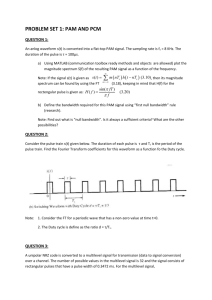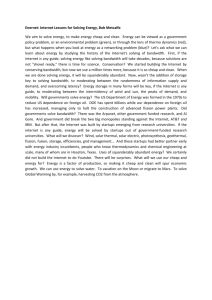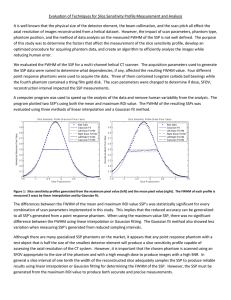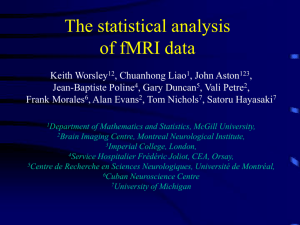How does the bandwidth of the oscilloscope and detector influence
advertisement
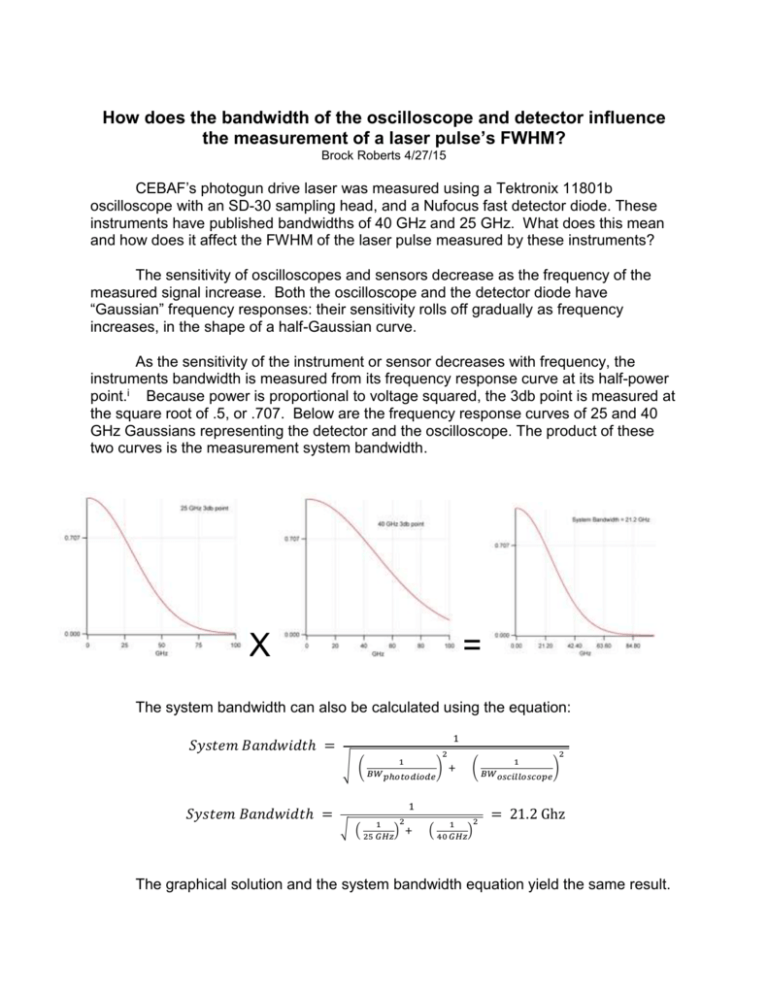
How does the bandwidth of the oscilloscope and detector influence the measurement of a laser pulse’s FWHM? Brock Roberts 4/27/15 CEBAF’s photogun drive laser was measured using a Tektronix 11801b oscilloscope with an SD-30 sampling head, and a Nufocus fast detector diode. These instruments have published bandwidths of 40 GHz and 25 GHz. What does this mean and how does it affect the FWHM of the laser pulse measured by these instruments? The sensitivity of oscilloscopes and sensors decrease as the frequency of the measured signal increase. Both the oscilloscope and the detector diode have “Gaussian” frequency responses: their sensitivity rolls off gradually as frequency increases, in the shape of a half-Gaussian curve. As the sensitivity of the instrument or sensor decreases with frequency, the instruments bandwidth is measured from its frequency response curve at its half-power point.i Because power is proportional to voltage squared, the 3db point is measured at the square root of .5, or .707. Below are the frequency response curves of 25 and 40 GHz Gaussians representing the detector and the oscilloscope. The product of these two curves is the measurement system bandwidth. X = The system bandwidth can also be calculated using the equation: 1 𝑆𝑦𝑠𝑡𝑒𝑚 𝐵𝑎𝑛𝑑𝑤𝑖𝑑𝑡ℎ = √ ( 2 1 𝐵𝑊𝑝ℎ𝑜𝑡𝑜𝑑𝑖𝑜𝑑𝑒 ) + ( 1 𝑆𝑦𝑠𝑡𝑒𝑚 𝐵𝑎𝑛𝑑𝑤𝑖𝑑𝑡ℎ = √ 2 1 ( ) + 25 𝐺𝐻𝑧 ( 2 1 ) 40 𝐺𝐻𝑧 1 𝐵𝑊𝑜𝑠𝑐𝑖𝑙𝑙𝑜𝑠𝑐𝑜𝑝𝑒 2 ) = 21.2 Ghz The graphical solution and the system bandwidth equation yield the same result. Gaussian systems are also described by their rise time. The system rise time is the measured 10-90 rise time of the systems response to a perfect step function. The measured rise time of a step function can be graphically calculated. This is done by graphically creating a step function and calculating its Fourier transform. The system bandwidth curve is multiplied with the step functions Fourier transform ii , the inverse Fourier transform of their product yields the step function as it is measured with a system bandwidth of 21.2 GHz. 𝐹 −1 (𝐹( )X( ))= Zooming in on the resultant step transition, the 10-90 rise time graphically measures 16.1 ps. The system rise time can also be calculated by the equation: 𝑅𝑖𝑠𝑒 𝑇𝑖𝑚𝑒 (𝑛𝑠) = 0.35 , 𝐵𝑎𝑛𝑑𝑤𝑖𝑑𝑡ℎ (𝐺𝐻𝑧) 0165 𝑛𝑠 = 0.35 , 21.2 𝐺𝐻𝑧 𝑟𝑖𝑠𝑒 𝑡𝑖𝑚𝑒 = 16.5𝑝𝑠 According to reference 3, the .35 values used in the equation above is an approximation and the “true” value for Gaussian systems is .339iii. Using this value in the above equation yields 16 ps, more accurately matching the graphical solution. The CEBAF laser pulse measurement: The CEBAF laser pulse was measured to be 48 ps FWHM using the photodiode and the oscilloscope described. Can the true FWHM of the laser pulse be determined by our knowledge of the system bandwidth and risetime? The graphical equation below can be used to mathematically describe the question; the leftmost Gaussian has an unknown FWHM. 𝐹 −1 (𝐹( )X( )) = To solve the graphical equation, many Gaussian waveforms were produced with FWHM’s incrementally smaller than 48 ps. The Gaussian bunch FWHM that was transformed by the system bandwidth to become 48 ps FWHM was: Laser FWHM = 45.75 ps Insights into High-Speed Detectors and High-Frequency Techniques. New Focus Application Note #1, High-Speed Photodetectors 15 and 25 GHz Photoreceivers– 12-ps Photodetectors i Understanding Oscilloscope Frequency Response and Its Effect on Rise-Time Accuracy Agilent Application Note 1420 ii Tektronix Technical Brief Bandwidth Alone ≠ Measurement Accuracy 55W-19248-2 iii





